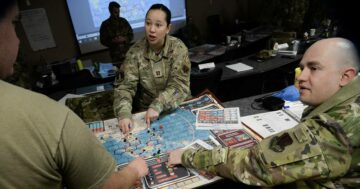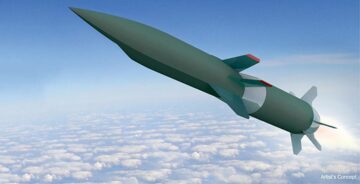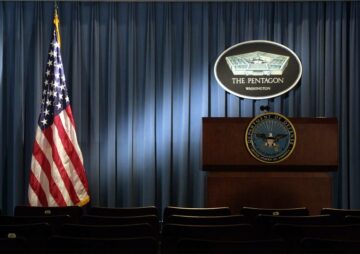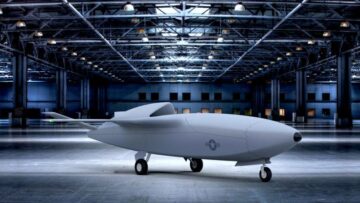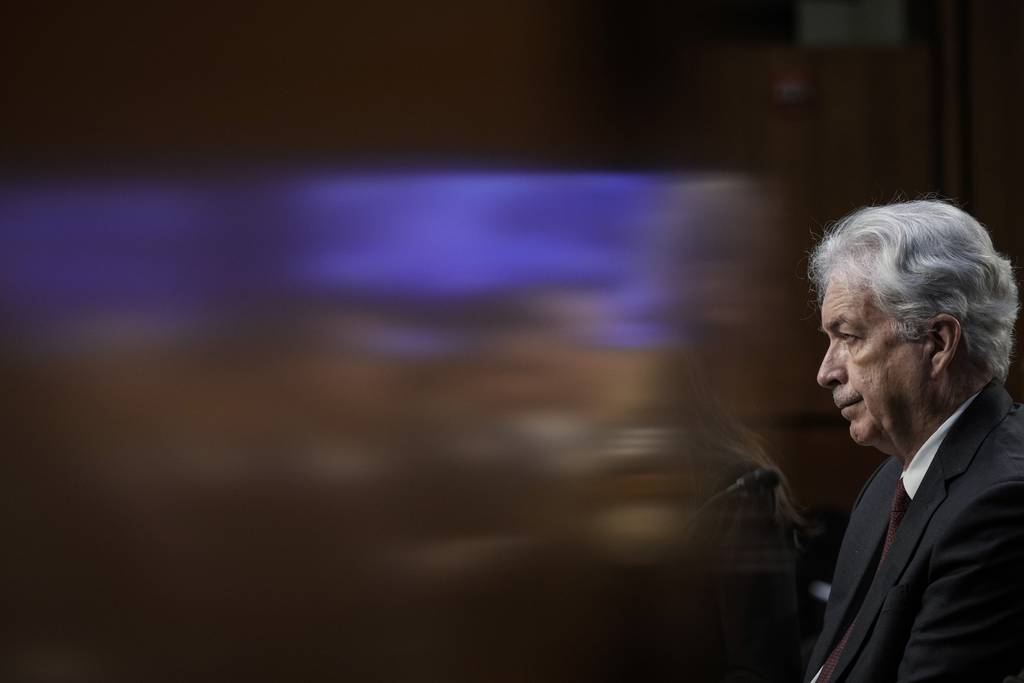
In his thoughtful and significant speech titled “A World Transformed and the Role of Intelligence,” CIA Director Bill Burns laid out his case for how intelligence plays a pivotal role at this “plastic moment” in history. He led his Ditchley Annual Lecture with the challenge of Russia and China, but his most revealing point was his discussion of how intense disruption by new technologies may be the most important and wide-ranging shock to the system we face today. He called this moment “a revolution in technology more profound than the industrial revolution or the dawn of the nuclear age.”
He is, of course, correct. Rapid technological change is reshaping the way we live, work and fight. The U.S. and China are competing to be first in space tech, biotech, quantum tech and a whole host of other techs that will create everything from life-saving medicine and climate solutions to life-ending bioweapons and artificial intelligence-enabled autonomous weapons systems.
This technological revolution hits the intelligence community hard, and in three earth-shaking ways.
First, primacy in innovation has shifted from the intelligence community to industry. Until recently, the intelligence community had long been on the bleeding edge of technological advancement, and as a result it knew what was on the horizon before anyone else. In his speech, Burns recalled the CIA’s innovation successes of past decades, but he also gave a nod to the uncomfortable truth that the vast majority of innovation happens outside government.
That is by no means a bad thing; having an in-house production capacity for an infinite number of potential needs is both expensive and foolish. Instead, the ideal arrangement is a lean, agile intelligence community with a wide industrial base to lean on for the perfect bespoke widget at the perfect time. But the intelligence community, being in the business of secrecy, has always struggled with the right balance of protection of secrets and sharing with the private sector. The risk calculus too often defaults to “nope,” which is a recipe for stasis and dangerous blind spots.
Second, the rapid pace of innovation means the intelligence community must work extremely hard to avert strategic surprise. Analysts and operators must interpret small signs to identify potential threats in competitors’ advancements. For example, a subset of financial technology — the suite of tools that allow for online money exchange — could disrupt one of the United States’ most often-used weapons: financial sanctions. Biotech could revolutionize medicine — or drive an efficient, terrible genocide — but these types of programs will be tightly held in the Chinese or Russian system.
The intelligence community is adapting to respond, albeit slowly. Burns said the CIA is “transforming our approach to emerging technology issues,” in part by creating a mission center focused solely on technology and transnational challenges. One of its mandates is to increase the CIA’s exchange with the private sector: a much-needed conduit to bring outside talent and treasure into what can be a miserable maze of security bureaucracy. But there is much more to be done.
Chasing the emerging-technology mission will be resource-intensive and will require thinking about the craft of intelligence in new ways. In our recent paper, “Move over JARVIS, meet OSCAR,” we argued that the combination of open-source intelligence, cloud computing technology and AI would revolutionize the business of intelligence, but only if the intelligence community is bold enough to try it. We nicknamed this new capability “OSCAR,” and we gave a set of recommendations describing how to get from here to there, looking at culture, security, policy, people and bold steps to take if progress stalls.
In a separate paper, “Seven Critical Technologies for Winning the Next War,” we made the case that seven technologies will make the difference in every aspect of strategic competition, and perhaps the most frightening of them is bioengineering. Burns also highlighted biotechnology as a development that is progressing on a “hockey stick” trend line: “Nowhere is that more evident than in biotechnology and biomanufacturing — which can unlock extraordinary climate and health solutions and boost our economies, but whose abuse and misuse could lead to catastrophe.”
The combinations of these technologies are far more impactful than the sum of their parts. Biology plus robotics could lead to self-healing or morphic robots, useful for long-term espionage in otherwise unreachable places. Facial recognition, AI, biosensors and high-performance computing can hand a state the ability to track a person through cities, airports, doctors’ offices, pharmacies, schools and toll roads — over multiple years, on multiple continents.
The latter combination of technologies in particular will make spy work more difficult than it has ever been, at a time when understanding our adversaries is even more vital. This is the third big impact on the intelligence community: Gathering information clandestinely is becoming nearly impossible in heavily surveilled environments.
Burns acknowledged this, describing the CIA as “in the midst of the most profound transformation of espionage tradecraft since the Cold War.” The challenge of ubiquitous technical surveillance will make human operations difficult and dangerous. Operators will need to go beyond living their cover; they will need to appear to exist in two places at the same time, or no places at all.
To meet these challenges and succeed in the competition with China, the intelligence community needs to reimagine how it takes new technologies from concept to creation to implementation at scale. Burns laid out the why, but not the how, of this transformation. We created a website called Tech Recs to help the U.S. government find a list of the Center for Strategic and International Studies’ recommendations for how to create smart tech policy for intelligence and defense. Implementing these recommendations will give the U.S. the best possible shot at getting to the vision of a modern, capable, cutting-edge technology ecosystem that Director Burns described.
Director Burns correctly identified this revolutionary moment. The intelligence community can talk about it and watch it pass by, or it can rise to the occasion, recognize the urgency and cast aside defunct practices. We need the audacity to dream big and the humility to let industry help.
Emily Harding is the deputy director and a senior fellow with the International Security Program at the Center for Strategic and International Studies think tank.
- SEO Powered Content & PR Distribution. Get Amplified Today.
- PlatoData.Network Vertical Generative Ai. Empower Yourself. Access Here.
- PlatoAiStream. Web3 Intelligence. Knowledge Amplified. Access Here.
- PlatoESG. Automotive / EVs, Carbon, CleanTech, Energy, Environment, Solar, Waste Management. Access Here.
- BlockOffsets. Modernizing Environmental Offset Ownership. Access Here.
- Source: https://www.defensenews.com/opinion/2023/07/26/three-ways-a-technological-revolution-will-impact-the-intel-community/
- :has
- :is
- :not
- 1
- 70
- a
- ability
- About
- about IT
- abuse
- acknowledged
- advancement
- advancements
- age
- agile
- AI
- Airports
- All
- allow
- also
- always
- an
- Analysts
- and
- annual
- anyone
- appear
- approach
- ARE
- argued
- arrangement
- AS
- aspect
- At
- autonomous
- avert
- Bad
- Balance
- base
- BE
- becoming
- been
- before
- being
- bespoke
- BEST
- Beyond
- Big
- Bill
- biology
- biomanufacturing
- biotechnology
- Bleeding
- Bleeding Edge
- blind
- bold
- boost
- both
- bring
- bureaucracy
- burns
- business
- but
- by
- called
- CAN
- capability
- capable
- Capacity
- case
- Center
- challenge
- challenges
- change
- China
- chinese
- cia
- Cities
- Climate
- Cloud
- cloud computing
- cold
- Columbia
- combination
- combinations
- community
- competing
- competition
- computing
- concept
- correct
- correctly
- could
- course
- cover
- craft
- create
- created
- Creating
- creation
- critical
- Culture
- cutting-edge
- cutting-edge technology
- Dangerous
- decades
- defaults
- Defense
- defunct
- deputy
- described
- Development
- difference
- difficult
- Director
- discussion
- Disrupt
- Disruption
- done
- dream
- drive
- economies
- ecosystem
- Edge
- efficient
- else
- emerging
- Emerging Technology
- enough
- environments
- espionage
- Even
- EVER
- Every
- everything
- evident
- example
- exchange
- exist
- expensive
- extraordinary
- extremely
- Face
- facial
- facial recognition
- far
- fellow
- fight
- financial
- Financial Sanctions
- Find
- First
- focused
- For
- from
- gathering
- gave
- get
- getting
- Give
- Go
- Government
- had
- hand
- happens
- Hard
- having
- he
- Health
- heavily
- Held
- help
- here
- high-performance
- Highlighted
- his
- history
- Hits
- horizon
- host
- How
- How To
- HTTPS
- human
- ideal
- identified
- identify
- if
- images
- Impact
- impactful
- implementation
- implementing
- important
- impossible
- in
- Increase
- industrial
- Industrial Revolution
- industry
- information
- Innovation
- instead
- Intel
- Intelligence
- International
- into
- issues
- IT
- ITS
- jpg
- lead
- Lecture
- Led
- let
- Line
- List
- live
- living
- Long
- long-term
- looking
- made
- Majority
- make
- mandates
- May..
- means
- medicine
- Meet
- Mission
- Modern
- moment
- money
- more
- most
- much
- much-needed
- multiple
- must
- nearly
- Need
- needs
- New
- New technologies
- next
- no
- nuclear
- number
- occasion
- of
- offices
- often
- on
- ONE
- online
- only
- open source
- Operations
- operators
- or
- Other
- otherwise
- our
- out
- outside
- over
- Pace
- Paper
- part
- particular
- parts
- pass
- past
- People
- perfect
- perhaps
- person
- pivotal
- Places
- plato
- Plato Data Intelligence
- PlatoData
- plays
- plus
- Point
- policy
- possible
- potential
- practices
- private
- private sector
- Production
- profound
- Program
- Programs
- Progress
- progressing
- protection
- rapid
- recent
- recently
- recipe
- recognition
- recognize
- recommendations
- require
- resource-intensive
- Respond
- result
- revealing
- Revolution
- revolutionary
- revolutionize
- right
- Rise
- Risk
- roads
- robotics
- robots
- Role
- Russia
- russian
- s
- Said
- same
- Sanctions
- Scale
- Schools
- sector
- security
- senior
- separate
- set
- seven
- sharing
- shifted
- shot
- significant
- Signs
- since
- Slowly
- small
- smart
- solely
- Solutions
- speech
- State
- Steps
- Strategic
- studies
- succeed
- suite
- surprise
- surveillance
- system
- Systems
- Take
- takes
- Talent
- Talk
- tank
- tech
- tech policy
- Technical
- technological
- Technologies
- Technology
- TECHs
- than
- that
- The
- their
- Them
- There.
- These
- they
- thing
- Think
- think tank
- Thinking
- Third
- this
- threats
- three
- Through
- tightly
- time
- titled
- to
- today
- too
- tools
- track
- Transformation
- transformed
- transnational
- Trend
- truth
- try
- two
- types
- u.s.
- U.S. government
- ubiquitous
- understanding
- United
- unlock
- unreachable
- until
- urgency
- Vast
- via
- vision
- vital
- war
- was
- Watch
- Way..
- ways
- we
- Weapons
- Website
- What
- when
- which
- whole
- whose
- why
- wide
- wider
- will
- winning
- with
- Work
- world
- would
- years
- zephyrnet



